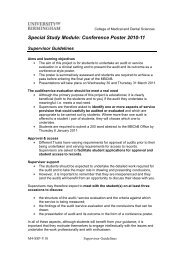Contents - College of Medical and Dental Sciences - University of ...
Contents - College of Medical and Dental Sciences - University of ...
Contents - College of Medical and Dental Sciences - University of ...
You also want an ePaper? Increase the reach of your titles
YUMPU automatically turns print PDFs into web optimized ePapers that Google loves.
The 11 th International Workshop on KSHV & Related Agents, Birmingham, UK<br />
Pathogenesis Abstract 19<br />
KAPOSI'S SARCOMA ASSOCIATED HERPES VIRUS (KSHV/HHV-8) INDUCES<br />
ANGIOGENIN DURING INFECTION OF HUMAN DERMAL MICROVASCULAR<br />
ENDOTHELIAL (HMVEC-D) CELLS THAT IS CRITICAL FOR ANTI-APOPTOSIS,<br />
CELL PROLIFERATION AND ANGIOGENESIS<br />
Sathish Sadagopan, Neelam-Sharma Walia, Mohanan Valiya Veettil, Virginie Bottero, Rita<br />
Levine <strong>and</strong> Bala Ch<strong>and</strong>ran<br />
H.M. Bligh cancer research laboratories, Department <strong>of</strong> Microbiology <strong>and</strong> Immunology,<br />
Chicago <strong>Medical</strong> School, Rosalind Franklin <strong>University</strong> <strong>of</strong> Medicine <strong>and</strong> Science, Chicago, IL<br />
Abstract<br />
De novo KSHV infection <strong>of</strong> HMVEC-d cells results in increased expression <strong>and</strong> secretion <strong>of</strong><br />
angiogenin, a multifunctional angiogenic protein. KS tissue sections were positive for<br />
angiogenin highlighting the importance <strong>of</strong> angiogenin in KS pathogenesis. Viral gene<br />
expression was critical for the sustained angiogenin secretion during primary infection.<br />
KSHV ORF 73 (latent) <strong>and</strong> ORF 74 (lytic) genes induced an increased secretion <strong>of</strong><br />
angiogenein. TIVE cells latently infected with KSHV secreted high levels <strong>of</strong> angiogenin.<br />
Angiogenin bound to surface actin, internalized in a microtubule independent manner,<br />
translocated into the nucleus when the cells were semi-confluent <strong>and</strong> became nucleolar<br />
in sub-confluent cells. In the nucleolus, angiogenin bound to the upstream sequence <strong>of</strong><br />
45SrRNA promoter <strong>and</strong> increased 45SrRNA transcription. Angiogenin increased the antiapoptosis<br />
<strong>and</strong> cell proliferation <strong>of</strong> KSHV infected endothelial cells, <strong>and</strong> these activities<br />
were blocked by neomycin which blocked the nuclear translocation <strong>of</strong> angiogenin.<br />
Upregulation <strong>of</strong> angiogenin lead to an increased activation <strong>of</strong> urokinase plasminogen<br />
activator <strong>and</strong> generation <strong>of</strong> active plasmin from inactive plasminogen. Plasmin generation<br />
aided the migration <strong>of</strong> endothelial cells towards chemoattractant including angiogenin,<br />
<strong>and</strong> chemotaxis was prevented by the inhibition <strong>of</strong> angiogenin nuclear translocation.<br />
Tube formation <strong>of</strong> endothelial cells was significantly inhibited by treating infected cell<br />
supernatants with anti-angiogenin antibodies. Inhibition <strong>of</strong> nuclear translocation <strong>of</strong><br />
angiogenin also blocked VEGF-C expression. Collectively, these results suggest that KSHV<br />
induced angiogenin plays multiple roles during infection such as increase in 45SrRNA<br />
synthesis, proliferation, cell migration <strong>and</strong> angiogenesis, <strong>and</strong> blocking angiogenin could<br />
have a therapeutic value in treating KSHV infection <strong>and</strong> KS.<br />
Presenting author Email: bala.ch<strong>and</strong>ran@rosalindfranklin.edu<br />
41















